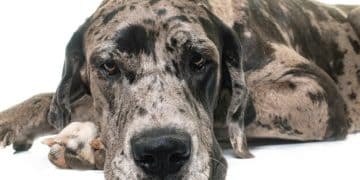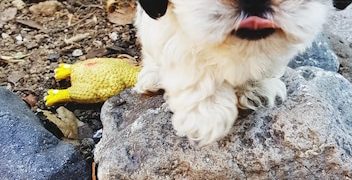Bloat in Dogs: Recognizing Symptoms & Saving Your Pet’s Life
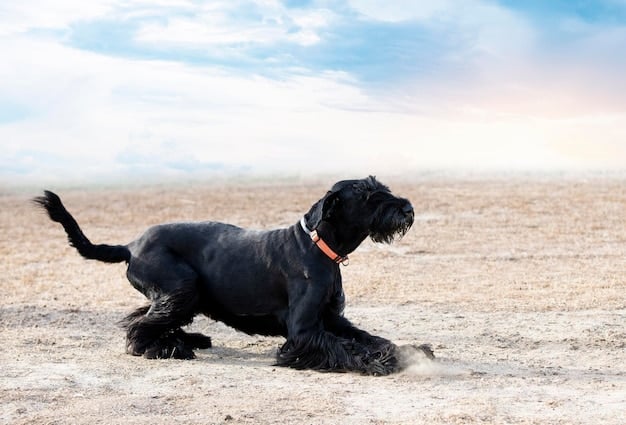
Bloat in dogs, also known as gastric dilatation-volvulus (GDV), is a life-threatening condition where the stomach fills with gas and twists, cutting off blood supply; recognizing symptoms like restlessness, distended abdomen, and unproductive retching and acting quickly by seeking immediate veterinary care is crucial to saving your pet’s life.
Imagine your furry friend suddenly restless, their belly swollen like a balloon. This could be bloat, a deadly condition in dogs. Knowing the signs and acting fast is crucial.
Understanding Bloat in Dogs
Bloat in dogs, technically known as gastric dilatation-volvulus (GDV), is a serious and life-threatening condition. Understanding what it is, why it happens, and which dogs are most at risk is the first step in protecting your beloved pet.
GDV occurs when a dog’s stomach fills with gas, fluid, or food, causing it to expand. This expansion can put pressure on other organs, restrict blood flow, and make it difficult for the dog to breathe. Even more dangerously, the bloated stomach can twist (volvulus), cutting off its own blood supply and trapping the gas inside. This leads to rapid tissue death and shock.
What Causes Bloat?
The exact cause of bloat is not fully understood, but several factors can contribute. These include rapid eating, eating large meals, excessive drinking after eating, and strenuous exercise after eating.
Certain breeds are also predisposed to bloat due to their deep chests and narrow waists giving the stomach more room to twist. Stress and anxiety can also play a role. It’s important to note that any dog can develop bloat, regardless of breed or size.
Breeds at Higher Risk
While any dog can get bloat, some breeds are significantly more prone to it. Knowing if your dog is one of these breeds means you’ll be more vigilant about preventative measures and recognizing the early signs.
- Great Danes
- German Shepherds
- Standard Poodles
- Irish Setters
These breeds share characteristics like deep chests and a higher body weight, making them more susceptible to the stomach twisting associated with GDV. Other breeds, such as Saint Bernards, Weimaraners, and Akitas, also have an increased risk.
In conclusion, understanding the basics of bloat, including its causes and at-risk breeds, is crucial for responsible dog ownership. This knowledge empowers you to take preventive measures and act quickly if your dog shows any signs of this dangerous condition.
Recognizing the Early Signs of Bloat
Early detection of bloat in dogs is often the key to a successful outcome. Learning to recognize the subtle signs can give your dog a much better chance of survival.
Bloat can progress rapidly, so it’s vital to know what to look for. The sooner you recognize the signs and seek veterinary attention, the better the prognosis for your furry friend. Don’t hesitate to err on the side of caution. Even if it turns out to be something else, it’s always better to be safe than sorry.
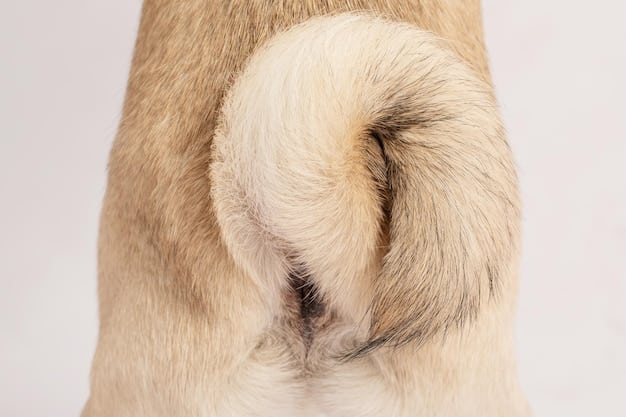
Common Symptoms to Watch For
Several symptoms can indicate your dog is experiencing bloat. These can range from mild discomfort to severe distress, so it’s important to be aware of the full spectrum of possibilities.
Keep a close eye on your dog’s behavior and physical appearance, especially after meals or exercise. If you notice any combination of these symptoms, seek veterinary help immediately.
- Restlessness and pacing
- Unproductive retching or attempts to vomit
- Distended or swollen abdomen
- Excessive drooling
Other signs may include visible discomfort, such as whining or panting, and a reluctance to lie down. In severe cases, the dog may collapse due to shock. It’s important to remember that not all dogs will exhibit all of these symptoms, and the severity can vary. Taking your dog’s vital signs, especially heart rate and gum color, can provide further signs of the overall health of your dog.
Therefore, knowing these warning signs can help you get your dog the crucial and timely veterinary care. Early signs are key to a more positive outcome.
Immediate Actions to Take if You Suspect Bloat
If you suspect your dog is suffering from bloat in dogs, every second counts. Knowing how to react in a calm and efficient manner can significantly improve your dog’s chances of survival.
Panicking will only make the situation worse, both for you and for your dog. Take a deep breath and move quickly and decisively. Here’s a step by step guide:
Contact Your Veterinarian Immediately
The very first thing you should do is call your veterinarian or the nearest emergency veterinary clinic. Explain the situation clearly and concisely, describing the symptoms you’ve observed.
You have to let them know you suspect bloat and that it’s a life-threatening emergency. This will allow them to prepare for your arrival and potentially give you specific instructions, such as withholding water.
Prepare for Transport
While you’re on the phone, ask the veterinary staff for any specific instructions about transporting your dog. They may advise you on the safest way to move your pet, especially if they are large.
Make sure your car is ready and have someone else drive if possible, so you can focus on monitoring your dog’s condition during the trip. If your dog is very large and can’t walk, you may need to find a way to transport them on a blanket or stretcher.
- Stay calm to reduce your dog’s stress.
- Keep your dog as comfortable as possible during transport.
- Avoid giving your dog anything to eat or drink unless instructed by the vet.
In conclusion, acting quickly and decisively and contacting your veterinarian as fast as possible can greatly improve your dog’s life because immediate and timely care is often vital.
Veterinary Treatments for Bloat (GDV)
Once you arrive at the veterinary clinic, the veterinary medical team will swing into action. The treatment for bloat in dogs is complex and typically involves several steps to stabilize the dog and relieve the pressure on the stomach.
The exact course of treatment will depend on the severity of the bloat and whether the stomach has twisted. However, here’s what you can generally expect.
Stabilization and Decompression
The first priority is to stabilize your dog. This may involve administering oxygen, placing an intravenous (IV) catheter for fluids and medication, and monitoring their heart rate and blood pressure.
The vet will then attempt to decompress the stomach to relieve the pressure. This can be done in a few ways: One method is to pass a tube down the esophagus into the stomach to release the gas and fluid. Another method involves inserting a needle directly into the stomach through the abdominal wall to release the trapped gas. Sometimes the needle decompression has to be done quickly to provide relief, as the esophageal tube can take more time.
Surgical Intervention
If the stomach has twisted (volvulus), surgery is necessary. The surgeon will untwist the stomach and assess the damage to the stomach wall. Severely damaged tissue may need to be removed.
To prevent future episodes of bloat, the surgeon will often perform a gastropexy, where the stomach is permanently attached to the abdominal wall. This procedure helps to anchor the stomach in place and prevent it from twisting again. It’s important to discuss the benefits and risks of gastropexy with your veterinarian.
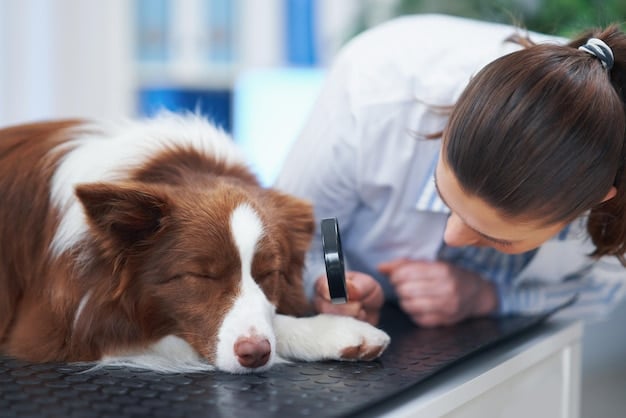
In short, veterinary intervention is crucial for treating bloat in dogs; if you suspect your pet has bloat, contact your veterinarian as soon as possible.
Preventative Measures to Reduce the Risk of Bloat
While there’s no guaranteed way to prevent bloat in dogs, you can take proactive steps to minimize your dog’s risk. Small adjustments to your dog’s feeding routine or lifestyle can make a big difference.
It’s important to understand that these general guidelines might need to be tailored to your dog’s specific needs and breed predispositions. Always consult with your veterinarian to develop a comprehensive prevention plan. Here are a few techniques:
Feeding Strategies
How you feed your dog can have a significant impact on their risk of developing bloat. Consider these strategies to promote healthier digestion.
Instead of feeding one large meal a day, divide their daily food ration into two or three smaller meals and feed your dog in a comfortable and quiet atmosphere. When a dog eats to quickly, they may also be swallowing air, which can contribute to bloat. You can buy slow-feeder bowls or utilize puzzle feeders to force them to slow down.
Exercise Management
Vigorous exercise immediately before or after eating can increase the risk of bloat. Adjust your dog’s exercise routine to minimize this risk.
Wait at least one to two hours after a meal before allowing your dog to engage in strenuous activity. Similarly, avoid feeding your dog immediately after exercise. Allow them to cool down and rest before offering food.
- Avoid strenuous exercise one hour before or two hours after eating.
- Ensure your dog has a calm environment during meal times.
- Maintain consistent feeding schedules to reduce anxiety.
Therefore, preventive measures in feeding strategies and excercise combined with regular veterinarian check-ups can ensure your dog is happy and healthy.
Long-Term Care and Monitoring After Bloat
Even after successful treatment for bloat in dogs, ongoing care and monitoring are essential to ensure your dog’s long-term health and prevent recurrence. It is important to pay close attention to any changes in their behavior, appetite, or physical condition.
Follow-up veterinary visits are crucial, and you should work closely with your veterinarian to develop a long-term care plan that addresses your dog’s individual needs. Early detection and prompt intervention is always the best policy.
Dietary Adjustments
Your veterinarian may recommend specific dietary changes to prevent future episodes of bloat. These adjustments can depend on the individual dog. Your veterinarian might also suggest probiotics or digestive enzymes to promote a healthy gut microbiome.
Monitoring for Recurrence
Be vigilant for any signs of bloat recurring, such as restlessness, abdominal distension, or unproductive retching. If you notice any of these symptoms, seek veterinary attention immediately.
Ensure fresh water is always available but avoid letting your dog gulp down large amounts of water quickly, especially after eating or exercising. Provide water in a controlled manner or use a slow-drinking bowl to encourage slower consumption.
To sum up, long-term care and attentive monitoring is important for your dog’s health; contact your veterinarian if anything seems odd.
| Key Point | Brief Description |
|---|---|
| 🚨 Recognize Symptoms | Watch for restlessness, distended abdomen, and unproductive retching. |
| Vet Immediately | Contact your veterinarian or emergency clinic right away; bloat is an emergency. |
| 🍽️ Feeding Habits | Feed smaller, more frequent meals to avoid overloading the stomach. |
| 🧘 Exercise Timing | Avoid strenuous exercise immediately before or after meals. |
Frequently Asked Questions
▼
Bloat, or gastric dilatation-volvulus (GDV), is a life-threatening condition where the stomach fills with gas and may twist, cutting off blood supply and causing shock.
▼
Large, deep-chested breeds like Great Danes, German Shepherds, and Standard Poodles are at higher risk. However, any dog can develop bloat.
▼
Bloat can be fatal within hours if left untreated. Immediate veterinary intervention is crucial to increase the chances of survival.
▼
While not always preventable, feeding smaller, more frequent meals and avoiding exercise before/after eating can reduce the risk of bloat.
▼
A gastropexy is a surgical procedure that attaches the stomach to the abdominal wall to prevent it from twisting again, often performed after bloat.
Conclusion
In conclusion, being proactive about recognizing the symptoms of bloat, understanding the risk factors, and knowing what to do in an emergency can significantly improve your dog’s chances of survival. Always consult with your veterinarian regularly to ensure your dog’s overall health and well-being and minimize the risk of bloat.
